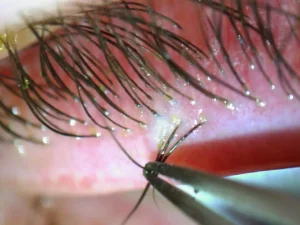The Hidden Culprits Behind Your Eye Discomfort
Have you ever experienced persistent eye irritation, redness, or itchy eyelids that just won’t go away despite regular cleansing? The cause might be microscopic mites living on your eyelids and lashes. These tiny creatures, known as Demodex mites, are the most common ectoparasites found on human skin and can significantly impact your eye health when their populations grow unchecked.
What Are Demodex Mites?
Demodex mites are microscopic organisms that naturally inhabit human skin, particularly in areas rich in sebaceous (oil) glands. Two species commonly affect humans:
- Demodex folliculorum: These elongated mites (about 0.3-0.4 mm long) live in clusters around hair follicles, including eyelash follicles, where they feed on sebum and skin cells.
- Demodex brevis: Slightly shorter and typically more solitary, these mites prefer to live deeper in the sebaceous glands.
While nearly everyone has these mites in small numbers (they’re part of our normal skin microbiome), problems arise when their populations increase excessively—a condition known as demodicosis.
How Demodex Affects Your Eyes
When Demodex mites overpopulate around your eyes, they can cause various eye conditions:
Demodex Blepharitis
Blepharitis is inflammation of the eyelids, and Demodex mites are associated with over two-thirds of blepharitis cases in the United States. This condition affects approximately 25 million Americans and is characterized by:
- Redness and inflammation of the eyelid margins
- Itching and burning sensations
- Crusty or flaky skin near the lashes
- Cylindrical dandruff or “collarettes” around the base of eyelashes (a telltale sign of Demodex)
- Dry, irritated eyes
Other Eye Conditions Linked to Demodex
Beyond blepharitis, Demodex overpopulation can contribute to:
- Meibomian Gland Dysfunction (MGD): Blockage of oil-producing glands in your eyelids, leading to dry eye symptoms
- Eyelash Problems: Including misdirected lashes (trichiasis), eyelash loss (madarosis), or distorted lash growth
- Conjunctivitis: Inflammation of the eye’s outer membrane
- Corneal Issues: In severe cases, inflammation can affect the cornea
Risk Factors for Demodex Overpopulation
Several factors can increase your risk of developing problematic Demodex infestations:
- Age: Infestation rates increase significantly with age, with higher prevalence in people over 60
- Skin Conditions: People with rosacea have higher Demodex populations
- Immune System: Those with weakened immune systems are more susceptible
- Poor Eyelid Hygiene: Inadequate cleansing allows mites to flourish
- Contact Lens Wear: Can sometimes exacerbate symptoms
- Makeup Use: Especially when shared or not removed properly
How to Identify a Demodex Problem
Only an eye care professional can definitively diagnose Demodex infestation. During an eye examination, your doctor may:
- Use a slit lamp with high magnification to examine your eyelashes
- Look for cylindrical dandruff or “collarettes” at the base of eyelashes (considered pathognomonic or definitively characteristic of Demodex blepharitis)
- Possibly examine an eyelash sample under a microscope to confirm the presence of mites
Treating Demodex Infestations
If you’re diagnosed with a Demodex-related eye condition, several treatment approaches may help:
Daily Eyelid Hygiene
- Warm compresses to loosen debris and oils
- Gentle eyelid scrubs with recommended cleansers
- Tea tree oil-based products (at appropriate concentrations), which have anti-parasitic properties effective against Demodex
Medical Treatments
- Prescription Medications: In 2023, the FDA approved Xdemvy (lotilaner ophthalmic solution), the first medication specifically for treating Demodex blepharitis
- In-office Procedures: Professional eyelid cleaning, thermal pulsation treatments, or intense pulsed light (IPL) therapy may be recommended
Preventive Measures
- Wash bedding, towels, and pillowcases regularly
- Never share eye makeup, brushes, or eye care products
- Remove makeup thoroughly before sleeping
- Maintain good hand hygiene, especially before touching your eyes
When to See an Eye Doctor
Consider consulting an eye care professional if you experience:
- Persistent eye irritation or redness
- Itchy, crusty, or flaky eyelids
- Frequent styes or chalazia (eyelid cysts)
- Eyelash loss or misdirection
- Eye discomfort that doesn’t improve with regular cleansing
The Bigger Picture
Understanding the role of Demodex mites in eye health is essential for effective treatment of persistent eye irritation. While these mites are a normal part of our skin’s ecosystem, keeping their populations in check through proper eyelid hygiene and professional treatment when necessary can significantly improve your eye comfort and overall ocular health.
Remember that Demodex-related conditions are often chronic but manageable with appropriate care. Working with your eye care professional to develop a treatment plan can help you maintain healthy, comfortable eyes for years to come.
This article is for informational purposes only and does not constitute medical advice. Always consult with a qualified healthcare provider for diagnosis and treatment of medical conditions.




Leave a Reply